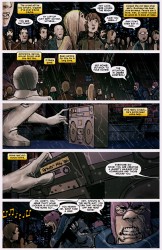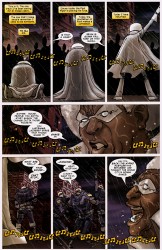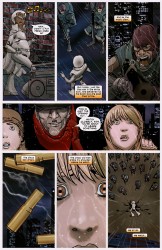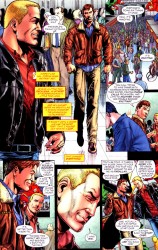I fell out of love with Alan Moore and Kevin O’Neill’s League of Extraordinary Gentlemen series. I thought the first volume was strong, the second volume less so, and I don’t think I even finished The Black Dossier. I’d changed or the series changed, I’m not entirely sure. It just wasn’t my thing. The series has moved to Top Shelf now, and the beginning of the fourth volume drops in April.
I gave the new League of Extraordinary Gentlemen volume a look. League of Extraordinary Gentlemen: Century: 1910 #1 (of 3) is a mouthful to say and a handful to read. It’s the first third of the new LoEG story, and, as the title suggests, takes place in 1910. The story itself will take place over the course of the 20th century, but this particular tale takes what seems like a very short period of time.
There are a few principal characters in the story. Jenny, daughter of Captain Nemo, has forsaken her father and his wishes for her life and gone to live in London. Rather than a life of luxury or spent lopping the heads off pirates, she ends up washing dishes and scrabbling for a living. Life sucks, in other words.
Mina is back and she’s leading this incarnation of the League. The team (which includes Allan Quatermain Jr. [a rejuvenated Quatermain], Anthony Raffles, and Orlando) is investigating a possible apocalypse, and doing a so-so job of it. There’s some light infighting within the group, and Mina seems constantly frustrated with her team, which provides some fairly interesting tension.
Finally, there is Mac the Knife, the real Jack the Ripper, a secret cabal, and a crew of unnamed and fairly sinister London citizens.
The various stories progress separately, before coming together shortly before the end of the book. It’s a tried and true storytelling device, and one that serves to make the entire book feel like it isn’t just a few completely disconnected stories. On a higher level, it ties into the three-issue structure of Century itself, and makes me assume that we’ll get a similar payoff once it’s all done.
O’Neill’s art, even in the b&w proof I was sent, is still stellar. The same attention to detail that he’s put into his past work, including previous LoEG volumes. Evil schemers look about as they should, Mina’s almost permanent exasperation with her team comes through very clearly, and the action scenes are gory and shocking.
Todd Klein’s lettering, as well, is definitely up to par. Lettering is tough for me to critique– if the letterer does his job, as Klein has done here, it adds a lot to the book, but in an intangible, “no duh” kind of way. It’s easier to talk about a bad lettering job than it is a good one, and Klein does a good job here.
Moore’s writing still strikes me as very well-crafted and good, if not a little distant. I don’t know that I left the book truly caring about any of the characters, though I was definitely invested in their adventures. There’s just something intangible there that still doesn’t quite work for me.
One thing I enjoy about Moore and Grant Morrison is that they expect a lot out of their readers. Morrison expects you to keep up and take things in stride, and Moore expects you to know a lot. I came away feeling entertained, but a little dumb. I can get by with Morrison’s ultramodern take, but here is what I know about early 1900s British pop culture: nothing.
LoEG is stacked with references, many of them I’d never heard of. I caught the obvious ones, such as Nemo, Mina Murray, and Jack the Ripper, but Pirate Jenny and a few others caught me flat-footed. Regardless, I kept going, making the effort to put some extra thought into the book, and made a mental note to look up the names on Wikipedia once I finished.
Despite the light feeling of being a little lost, which actually added a lot to the experience of reading the book, I found LoEG: Century: 1910 a rewarding read. At its most shallow level, it’s a comic about some pretty awesome pirates and early 1900s secret agents. Of course, since it’s a book written by Alan Moore, there are a number of levels that you can enjoy the work on. It even works as a primer for British literature. If you liked reading about Orlando or Raffles, google them up and check out the old tales.
LoEG: Century: 1910 shows what happens as a group begins the long, slow spiral into oblivion (or so I assume), and clearly sets up some things for the future, as well. There are parts that made me pretty uncomfortable, particularly a certain act set to song toward the end of the book, and parts I enjoyed, such as exactly what happens when the League meets up with a secret society.
I don’t think that it’s perfect, but it does give me the feeling I remember getting back when I read the first LoEG book. It feels new, in equal parts due to the fact that I’m not very experienced with the characters introduced in this volume and because there is a very interesting story being slowly unfolded. I’m very curious to see where Moore and O’Neill take it next, both on a story and a “spot the reference” level.





